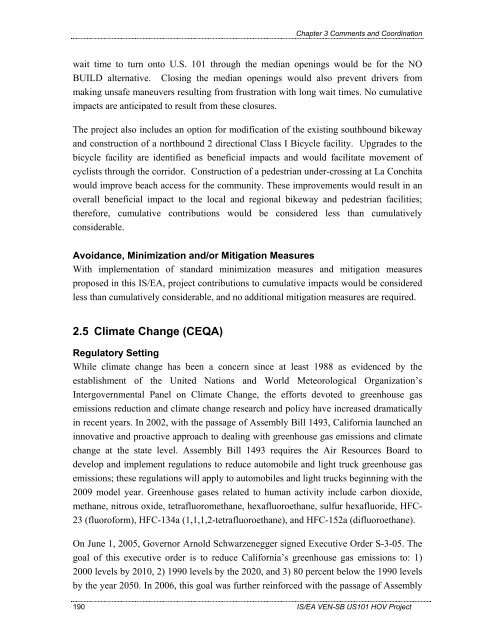Chapter 1 - Caltrans - State of California
Chapter 1 - Caltrans - State of California
Chapter 1 - Caltrans - State of California
You also want an ePaper? Increase the reach of your titles
YUMPU automatically turns print PDFs into web optimized ePapers that Google loves.
<strong>Chapter</strong> 3 Comments and Coordination<br />
wait time to turn onto U.S. 101 through the median openings would be for the NO<br />
BUILD alternative. Closing the median openings would also prevent drivers from<br />
making unsafe maneuvers resulting from frustration with long wait times. No cumulative<br />
impacts are anticipated to result from these closures.<br />
The project also includes an option for modification <strong>of</strong> the existing southbound bikeway<br />
and construction <strong>of</strong> a northbound 2 directional Class I Bicycle facility. Upgrades to the<br />
bicycle facility are identified as beneficial impacts and would facilitate movement <strong>of</strong><br />
cyclists through the corridor. Construction <strong>of</strong> a pedestrian under-crossing at La Conchita<br />
would improve beach access for the community. These improvements would result in an<br />
overall beneficial impact to the local and regional bikeway and pedestrian facilities;<br />
therefore, cumulative contributions would be considered less than cumulatively<br />
considerable.<br />
Avoidance, Minimization and/or Mitigation Measures<br />
With implementation <strong>of</strong> standard minimization measures and mitigation measures<br />
proposed in this IS/EA, project contributions to cumulative impacts would be considered<br />
less than cumulatively considerable, and no additional mitigation measures are required.<br />
2.5 Climate Change (CEQA)<br />
Regulatory Setting<br />
While climate change has been a concern since at least 1988 as evidenced by the<br />
establishment <strong>of</strong> the United Nations and World Meteorological Organization’s<br />
Intergovernmental Panel on Climate Change, the efforts devoted to greenhouse gas<br />
emissions reduction and climate change research and policy have increased dramatically<br />
in recent years. In 2002, with the passage <strong>of</strong> Assembly Bill 1493, <strong>California</strong> launched an<br />
innovative and proactive approach to dealing with greenhouse gas emissions and climate<br />
change at the state level. Assembly Bill 1493 requires the Air Resources Board to<br />
develop and implement regulations to reduce automobile and light truck greenhouse gas<br />
emissions; these regulations will apply to automobiles and light trucks beginning with the<br />
2009 model year. Greenhouse gases related to human activity include carbon dioxide,<br />
methane, nitrous oxide, tetrafluoromethane, hexafluoroethane, sulfur hexafluoride, HFC-<br />
23 (fluor<strong>of</strong>orm), HFC-134a (1,1,1,2-tetrafluoroethane), and HFC-152a (difluoroethane).<br />
On June 1, 2005, Governor Arnold Schwarzenegger signed Executive Order S-3-05. The<br />
goal <strong>of</strong> this executive order is to reduce <strong>California</strong>’s greenhouse gas emissions to: 1)<br />
2000 levels by 2010, 2) 1990 levels by the 2020, and 3) 80 percent below the 1990 levels<br />
by the year 2050. In 2006, this goal was further reinforced with the passage <strong>of</strong> Assembly<br />
190 IS/EA VEN-SB US101 HOV Project

















